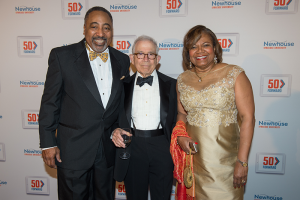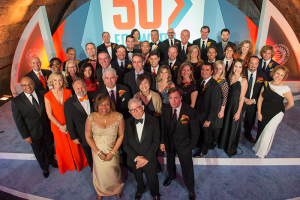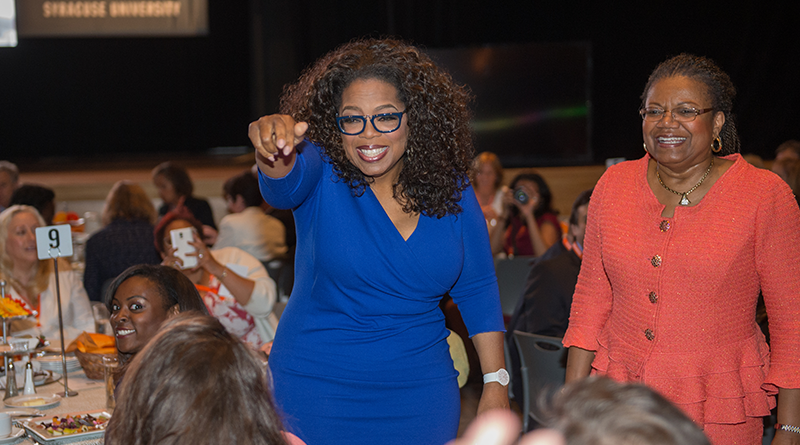A Trailblazer Marks a Milestone
Dean of SU’s Newhouse School of Public Communication completes 10 years on the job as the first female and the first person of color to occupy the position
By Mary Beth Roach

Lorraine Branham is the first female and the first person of color to serve as dean of Syracuse University’s S.I. Newhouse School of Public Communications, since it opened more than 50 years ago.
As such, she could well be considered a trailblazer, but it’s not something she makes a big deal about.
“I’ve often said, I don’t mind being the first, but I don’t want to be the last,” she said.
She has been the first female, the first African-American or both in many of the jobs she’s had in her career. For example, at her first academic appointment at the School of Communications at the University of Texas in Austin, she was the first female and first African-American full professor, and when she went to the Tallahassee Democrat newspaper as executive editor, she was the first woman and first person of color to hold that position, she noted.
“It’s been kind of the story of my life,” she remarked. “I want to open doors for others. It’s part of what I should do.”
The Newhouse years
Taking over the reins of the school in 2008, Branham, now in her 60s, is in her 10th year at Newhouse. Although she jokes that she will never adjust to Central New York winters, she loves the summers, the autumn and, of course, Newhouse.
Over her 10 years, she has developed numerous programs and internship opportunities and led a campaign to renovate Newhouse II.
“I see my role as making those things possible — making it possible for my faculty, my students, my staff to do their job well, have great experiences here and help prepare the next generation of communicators,” she said.
But she’s quick to add that she did not accomplish any of this alone.
“Of course, I didn’t do it single-handedly. I have a great staff and great faculty, and am blessed with really good students. David Rubin had been dean for 18 years — a very successful dean. It was big shoes to fill. My job was to not just sort of keep things status quo, but to take it to the next level,” Branham said.
Several new graduate programs, including an online version; the Los Angeles and New York Semesters professional development programs; an entrepreneurship initiative, and a sports broadcasting component have all been developed under her guidance.
In her travels, she was often asked whether Newhouse had an online program, which it had not. They eventually created Digital Communications for Media Professionals for those who are mid-career and interested in strengthening their digital skills, Branham said. It has attracted students from throughout the country and abroad, she noted.
The LA and New York Semesters allow students to spend a term in these cities, where they have internships during the day and classes in the evenings from adjuncts Newhouse hired in public relations, advertising, journalism, magazine, TV, radio, film and the business side of the media.
During her time at Newhouse, she has seen a number of alumni leave and start up their own businesses. Believing there was a need to better prepare students for this career path, she helped to create a center for digital media entrepreneurship to instruct students on how to run a business and to present opportunities for students who might not want to work for a magazine or for a network, and who instead want to start their own business.
“We’ve had a number of students who’ve come through and gone off to do that, and have been very successful,” she said.
She also helped in creating a sports program component at Newhouse.
“Newhouse had this great reputation for all of these sports broadcasters,” she said.
SU has turned out the likes of Bob Costas, Mike Tirico, Sean McDonough, and Marv Albert, to name just a few.
“I just assumed there was a sports program here. I was surprised there was none here,” she said. “But I saw more schools around the country starting sports programs, and I felt that Newhouse needed to do something official because otherwise we were going to start losing students who would go elsewhere.”
She has also helped to reshape the SU campus by overseeing a major campaign for Newhouse 2, and raised $18 million to do that.
When she arrived at SU and was meeting with Rubin, she discussed plans for the project with him.
She jokingly asked Rubin why he didn’t raise the money to do the renovation of Newhouse 2.
“He gives me this little grin of his and said, ‘I wanted to leave something for you to do,’” she said.
The task was a little daunting, she admitted, especially since money had just been raised for Newhouse III, and as such, many alumni and donors were tapped out, she said.
But the university was able to secure a naming gift from the family of the late Dick Clark, the entertainment legend and SU alum.
In 2014, the Newhouse Studio and Innovation Center opened at Newhouse 2. The facility includes the Dick Clark Studios, the Alan Gerry Center for Media Innovation and the Diane and Bob Miron Digital News Center.
Perhaps an even greater responsibility is preparing Newhouse students, which number about 1,900 undergraduates, 200 graduate students and about 30 to 35 Ph.D. candidates for roles in today’s media, at a time when technology evolves constantly.
“It’s extremely challenging, often frustrating. Everything is changing so quickly,” she said. “I feel fortunate to have the faculty. We really insist that our faculty stay connected to the industry. We bring people from the industry here and we go out. I’m constantly pushing for us to always be on the cutting edge. One of the reasons I go out to try to raise money is to make sure our students have opportunities, to have new experiences, that we have the latest equipment, that we are able to expose them to people and ideas, and send them places.”
But the most crucial point to stress to students is how to be analytical and good listeners, she said.
“I feel the best thing we can teach these kids is, in addition to some really hard skills, are the soft skills — to be a critical thinker; to be agile, because we’ll teach you software today that a year from now may not exist; understanding the concepts and how to communicate well. It is our biggest challenge,” Branham said.
Students have changed in the 15 years she’s been in academia, especially in terms of their exposure to social media, and that has required teachers to adapt how and what they teach.
Culture of social media
“These kids grew up on social media,” she said. “We have to teach them how to use it in a professional context,” she said. “But now these kids are really smart; they’re really savvy. They’ve come of age in this digital world and they just take these things for granted.

“Now, we can focus on teaching the foundational skills, and teach them how to be a success in whatever areas they decide to go into.”
She said it is vital to also show students a variety of ways to conduct research.
“We have to teach them there are other things other than Google, and also that you cannot believe everything you read,” she said. “That’s the thing. They just think if it’s online, it must be true,” Branham said.
Newhouse has been able to remain competitive, she said, estimating that it receives approximately 5,000 applications for 400 seats in the freshman class.
While the school could become larger, administrators don’t want to do that, instead preferring to keep class sizes small.
“One of the reasons we are able to do as well as we do is that faculty are really able to get to know their students. It’s really hands-on learning,” she said.
She also credits the alumni with much of the success that Newhouse enjoys.
“I enjoy interacting with our alum. The school really has great alumni who really care about the school,” she said. “They come back, they give back. It was one of the things I loved as I was trying to decide if I was going to leave Austin and come to the frozen North.
Newhouse School of Public Communication has been able to remain competitive.It receives approximately 5,000 applications for 400 seats in the freshman class.
“I was really struck by how dedicated the alumni is to this school. I just felt that it’s such a strategic advantage to have all these people who care so much about it,” she added.
Future of journalism
As she embarks on this milestone year, Branham reflected on her career and where journalism might be heading in the years to come.
A 1976 graduate of Temple University, the Philadelphia native had worked as a reporter for several newspapers in that area.
She then went to the Baltimore Sun as a reporter, and would go on to become its night city editor.
After a couple of years, she was at a crossroads, trying to figure out if she wanted to return to reporting or remain an editor.
To help sort this out, she attended Stanford University on a fellowship.
She ultimately decided to remain an editor, and went back to her hometown and worked for The Philadelphia Inquirer.
Hoping to one day run her own newspaper, she was advised to better understand the editorial and business side of the paper. As a result, she took a job as executive editor with the Tallahassee Democrat, which at the time was owned by Knight-Ridder.
She would eventually leave Florida and return to Pennsylvania as the assistant to the publisher at the Pittsburgh Post-Gazette.
The newspaper had recruited her, she said, with the idea that she would one day become the editor. But after two years, she came to realize that wasn’t going to happen.
So it was perfect timing when the call came from the University of Texas at Austin, which was looking for a director of its school of journalism.
“I just happened to get a call one day from a young woman who was on the search committee at Texas,” she recalled. “The women on the committee were very upset that they had three finalists and they were all white males. The women wanted a woman in the pool, so they said to go find one.”
Eventually, the woman got Branham’s name and reached out to her.
“I had been an adjunct in the past at Temple. I always liked teaching,” she noted. “I thought maybe I’ll go do this for awhile and I’ll go back to journalism. So I went for the interview, they liked me and I got the job.”
Although Branham has been in the field for decades — both as a reporter and an educator —she is concerned about the future of journalism and how to prepare students.
She cited financial pressures, the changes brought on by technology, the public’s view and the White House’s view of the media, entertainment news, and the demise of local newspapers.
“We have a president that is seeking to undermine journalism and convince people that journalists are enemies of the people. Our ratings among the public are going down; people often think that journalists can’t be trusted,” she said. “People don’t understand, as they once did I think, how important journalism is to a democratic society, why journalism matters,” she remarked.
She often shares with students one of her favorite quotes from Thomas Jefferson.
Although he was not necessarily a great friend of the press of his day, he said that if he had to choose between a government without newspapers or newspapers without a government, he would prefer the latter.
“Nowadays, you actually have in many parts of government, people who do see the press as an enemy,” she said.
“It never occurred to me that people might actually challenge the First Amendment, and that there might be courts that would not look favorably on the First Amendment,” she said.
“But as I see the courts being stacked, and people with a certain bent being put in these positions, I worry. Could we become one of those countries that throw journalists in jail? That shut down media and newspapers and other media organizations because they don’t like what they’re doing? It’s very disturbing,” she added.
“We’re at a very disturbing time in our history. And it’s not helped by the fact that we’ve lost a lot of credibility with the public, and we really have to work to regain that,” she said.
She said part of the reason the public has lost faith is the rise of entertainment and opinion journalism, and the demise of local papers.
“People loved their local paper; their local papers covered their local news. The media, for people, has just become this detached organization off in Washington or New York that you don’t relate to anymore, Branham said.
“They’re shells of themselves, or they’ve gone away, or they’ve been bought up by conglomerates and people don’t recognize them as their papers anymore,” she added.
She’s candid about the future of journalism, but what about her future?
“I’m thinking about that now. David was dean for 18 years. I don’t know if I want to be dean for 18 years,” she noted. “I may go back to teach for awhile when I do that.”

